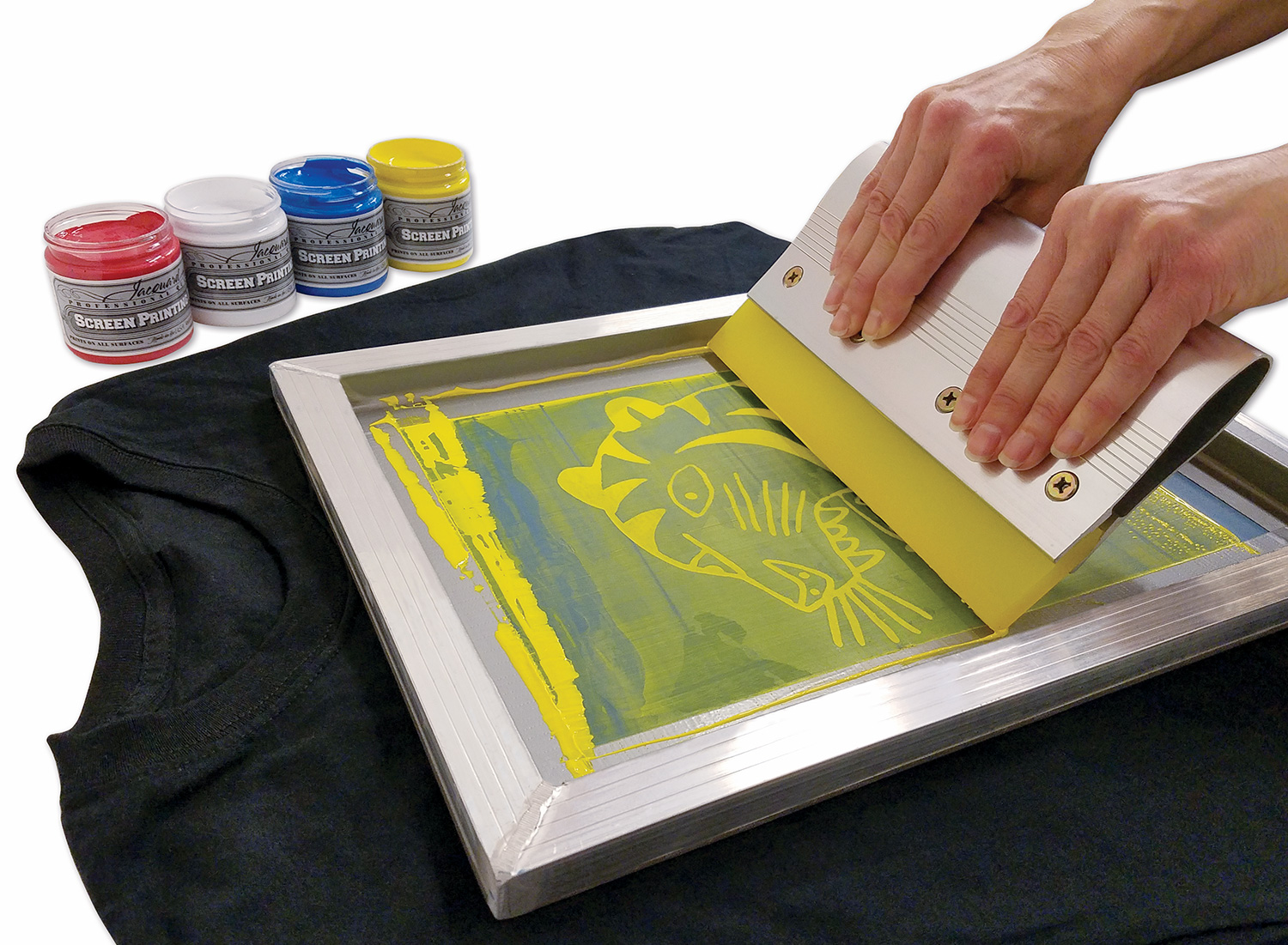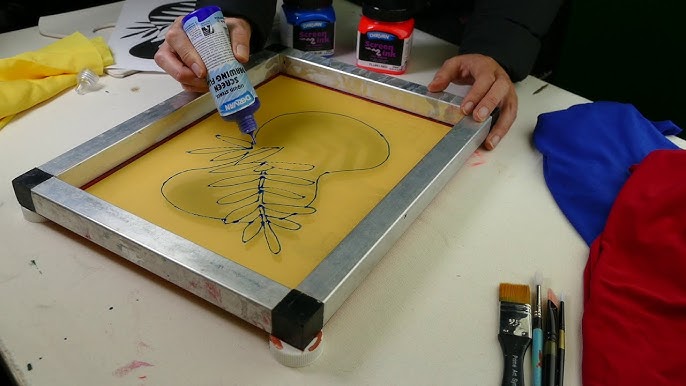From Style to Shipment: Grasping the Art of T-Shirt Screen Printing
The trip from layout to distribution in t-shirt screen printing encompasses a collection of critical stages that require interest to information and calculated preparation. It starts with comprehending the nuances of your target audience, adhered to by the selection of proper materials and the prep work of art work that meets high requirements. As the procedure unfolds, challenges in high quality control and logistics can emerge, potentially affecting the final end result. Checking out these intricacies exposes not just the ins and outs of screen printing but additionally the crucial methods that can elevate a brand's standing in a competitive market.
Recognizing T-Shirt Screen Printing
Recognizing T-Shirt screen printing involves recognizing a versatile and commonly used technique for transferring styles onto textile. This method utilizes a mesh and a stencil screen to use ink onto different textile products, mostly cotton and polyester blends. The procedure begins with the development of a screen that features the wanted design, which is after that carefully straightened on the material.
Ink is pressed with the screen's open areas utilizing a squeegee, permitting accurate application of shade. This method is favored for its capability to produce vibrant, long-lasting prints that stand up well to washing and put on. Additionally, screen printing is qualified of suiting both easy and complex styles, making it a favored choice for custom clothing, marketing products, and even artistic jobs.
Moreover, screen printing supplies scalability, making it appropriate for both tiny set orders and large manufacturings. While preliminary configuration costs might be greater contrasted to various other printing methods, the performance and toughness of screen printing commonly validate the financial investment. Overall, recognizing the fundamentals of T-shirt screen printing is essential for any person aiming to take part in this preferred kind of material decor, whether for business undertakings or individual projects.
Conceptualizing Your Layout
Conceiving your style is a crucial action in the Tee shirts screen printing process, as it establishes the structure for the whole job. This phase involves producing concepts that resonate with your target audience while ensuring that the style lines up with the brand's identification and message. It is necessary to begin by exploring motifs, color pattern, and graphics that reflect the intended aesthetic.
Mapping out initial principles can be valuable, enabling a graph of ideas prior to wrapping up the layout (T-Shirt Printing). Think about using typography, imagery, and design in a method that catches interest and interacts properly. Furthermore, it is essential to expect the printing method that will certainly be utilized, as this can influence style complexity and shade selections
Engaging in conceptualizing sessions with employee or looking for responses from prospective customers can also improve the conceptualization process, giving varied perspectives that refine the style. Ultimately, a well-balanced style not just improves the visual appeal of the Tees yet likewise promotes a connection with the audience, driving interest and prospective sales. Dedicating time to conceptualize your design can lead to a successful screen printing result.
Choosing the Right Materials
When selecting the right products for T-shirt screen printing, it is necessary to take into consideration the material's structure, texture, and weight, as these factors significantly influence the end product's top quality and feel. Cotton is a preferred choice due to its breathability, ability, and softness to absorb ink efficiently, making it excellent for dynamic prints - Business Branding Services. Blends, such as cotton-polyester, offer toughness and wrinkle resistance, yet may impact ink adherence, calling for careful factor to consider of printing techniques
The weight of the fabric, commonly determined in grams per square meter (GSM), affects the drape and total feel of the Tee shirts. Heavier fabrics may offer a much more exceptional look, while lighter choices are comfy for casual wear. Appearance also plays a function; smoother materials tend to produce sharper prints, while textured surfaces can produce distinct visual impacts.
Additionally, think about the environmental effect of materials. Organic cotton and recycled polyester are gaining popularity amongst eco-conscious consumers. Ultimately, selecting the best materials includes stabilizing visual allure, functionality, and sustainability, making sure that the T-shirt not just looks fantastic but also satisfies the assumptions of your target market.
Preparing Artwork for Printing

Preparing artwork for T-shirt screen printing requires cautious interest to information to ensure that the last print properly reflects the intended design. The very first step is to create a high-resolution digital file, preferably in vector format, as this allows for scalability without loss of top quality. Usual software program utilized for this purpose consists of Adobe Illustrator and CorelDRAW.

Think about the measurements of the print area and preserve correct margins to stay clear of layout cutoff. It's likewise important to consist of registration marks for positioning during the printing process. Lastly, demand an evidence from the printer to picture the last product before mass production. This action is essential for recognizing any kind of possible problems, assuring that the published Tee shirts satisfies the preferred quality and style specs. Appropriate preparation of art work considerably affects the general success of the screen printing job.
Mastering the Printing Process

Next, choosing the ideal ink is very important. Different ink types, such as plastisol or water-based, offer various finishes and longevity. Understanding the fabric composition of the T-shirt additionally helps in choosing compatible inks.
When it concerns the actual printing, controlling the squeegee pressure and angle is important. Consistent stress will certainly generate also ink distribution, while the angle affects the flow and coverage. Additionally, changing the speed of the printing press can affect the ink's curing process, which is basic for assuring longevity.
Quality Assurance and Finishing
After the printing procedure is total, implementing effective quality assurance procedures ends up being important to verify that each Tees satisfies the preferred standards. Quality assurance entails a methodical method to inspecting each garment for issues, verifying that the print high quality, shade accuracy, and material integrity straighten with the specs set throughout the style phase.
The primary step in quality assurance is a complete visual inspection. This involves checking for usual issues such as misalignment, ink smudges, or fading. Any kind of Tee shirts that does not meet the top quality benchmarks need to be attended to promptly, either with reprinting or repair.
In enhancement to visual checks, it is essential to perform laundry examinations on a sample of published t shirts to examine the resilience of the inks and the total longevity of the style. These tests visit assist validate that the print will preserve its vibrancy and honesty after multiple laundries, an important aspect for consumer fulfillment.
Finishing touches, such as string trimming and the application of care labels, likewise play a significant role in top quality control. By concentrating on these facets, companies can enhance the total discussion of their items, ultimately bring about a more rewarding consumer experience.
Packaging and Delivery Solutions
Effective packaging and shipment options are crucial components of the Tee shirts screen printing procedure, as they ensure that garments come to their destination in beautiful condition. Proper product packaging not only safeguards the printed layouts but likewise improves the unboxing experience for clients, strengthening brand identity and expertise.
To attain ideal product packaging, take into consideration making use of eco-friendly products that straighten with sustainability fads, such as recyclable poly bags or eco-friendly boxes. Each Tees must be neatly folded and placed in protective covering to avoid creasing and possible damages throughout transit. Including a well-known insert or treatment directions can even more customize the experience, fostering consumer commitment.
When it pertains to shipment, selecting a reputable shipping companion is necessary. Assess options based upon monitoring, expense, and speed capabilities. Providing multiple delivery methods can deal with different consumer requirements, from basic to expedited delivery.
Frequently Asked Inquiries
What Are the Usual Mistakes Newbies Make in Screen Printing?
Common blunders novices make in screen printing consist of incorrect screen prep work, inadequate ink blending, incorrect exposure times, not enough treating, and disregarding to evaluate prints. These mistakes can result in inadequate quality and poor cause last products.
Just How Can I Avoid Ink From Blood Loss During Printing?
To stop ink bleeding during printing, guarantee correct screen tension, use ideal emulsion thickness, choose the appropriate ink consistency, preserve excellent curing temperatures, and avoid straining the screen with excessive ink during application.
What Kinds of Inks Are Ideal for Various Fabrics?
Selecting inks based upon fabric type is necessary. Water-based inks are ideal for cotton, offering gentleness. Plastisol inks match artificial textiles, offering sturdiness (Abilene T-Shirt Screen Printing Company). Discharge inks successfully mix with all-natural fibers, making certain vivid shades without endangering textile honesty
Just how Do I Pick the Right Screen Mesh Matter?
Picking the appropriate screen mesh matter relies on the wanted print detail and ink kind. Greater mesh counts yield finer information, while reduced counts help with thicker inks. Evaluate fabric type and layout intricacy for suitable outcomes.
Can I Utilize Screen Printing for Small Set Orders?
Yes, screen printing can be efficiently utilized for small set orders. Business Branding Services Abilene. This technique enables for detailed layouts and high-quality outcomes, making it a feasible option for personalized clothing, promotional things, or restricted version runs
Comprehending T-Shirt screen printing involves identifying a versatile and extensively utilized method for moving designs onto material. While initial configuration costs might be greater compared to various other printing methods, the performance and toughness of screen printing commonly justify the financial investment. Preparing artwork for Tee shirts screen printing calls for cautious focus to detail to ensure that the last print accurately mirrors the intended style. Mastering the printing process is essential for attaining premium outcomes in Tees screen printing. Usual blunders novices make in screen printing consist of inappropriate screen prep work, poor ink mixing, inaccurate exposure times, not enough curing, and ignoring to examine prints.